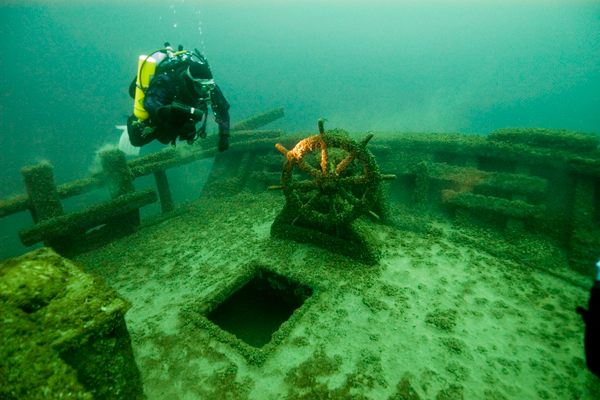The Fantastical Beauty of Sunken Ruins
Ominous landscapes of aquatic exploration.
Exploring the sunken treasures of Heracleion. (Photo: Christoph Gerigk courtesy Franck Goddio/Hilti Foundation)

Every empire comes to ruin. The technological marvels of today are the wreckage of the future. In this destruction there can be great beauty. Each of these sunken ruins, dating from ancient to modern times, is both enchanting and ominous: these are places where the thrill of exploration mixes with the foreboding knowledge that swimming among ruins is glimpse of our own potential future.
The Lost City of Heracleion
AL MAADEYAH, EGYPT


(Photo: Christoph Gerigk courtesy Franck Goddio/Hilti Foundation)
Appearing in a few rare inscriptions and ancient texts, the city of Thonis-Heracleion was not something anyone expected to find. No one was even looking for it.
So it was a shock when French archaeologist Franck Goddio saw a colossal face emerge from the water. Goddio had stumbled upon the completely submerged Thonis-Heracleion four miles off Alexandria’s coastline. Among the underwater ruins were 64 ships, 700 anchors, a treasure trove of gold coins, and statues standing at 16 feet.
Most notable were the remains of a massive temple to the god Amun-Gereb, and the tiny sarcophagi for the animals that were brought there as offerings. Once a grand city, today its history is largely obscured. No one is quite sure how it ended up entirely underwater.
The Sunken City of Baia
BAIA, ITALY
 .A sunken statue. (Photo: Courtesy of The Underwater Archeological Park of Baia)
.A sunken statue. (Photo: Courtesy of The Underwater Archeological Park of Baia)In its heyday, the classical Roman city of Baia was the Las Vegas of its time. Now its remains are beneath the waves.
A prominent resort city for centuries, Baia catered to the recreational whims of rich and powerful Romans. The city, which was located over natural volcanic vents, was famous for its healing medicinal hot springs. Some of antiquity’s most powerful figures, including Nero, Cicero, and Caesar, were known to have visited the city; a number of them built permanent vacation villas there.
Today the ancient remains of Baia can be visited in one of the world’s few underwater archaeological parks. Visitors can view crumbled structures and amazingly preserved statuary through glass-bottomed boats, or scuba dives that allow people to actually swim amongst the copious ruins. While the city is no longer a resort, its waters still hold wonders.
Sunken Cemetery
CAMIGUIN ISLAND, PHILIPPINES
 The graves of the sunken cemetery. (Photo: Atlas Obscura User Aribancale)
The graves of the sunken cemetery. (Photo: Atlas Obscura User Aribancale)There are no flowers to mark the resting places of the lost citizens of Camiguin—instead a giant cross rises up out of the water marking where this cemetery once was.
In the 1870s, a volcano near the island erupted and caused the capital city, including this cemetery, to sink below sea level. In order to commemorate the loss, a looming cross was built in remembrance. Beneath the surface are the remains of the cemetery itself.
Shi Cheng
HANGZHOU SHI, CHINA
 In the submerged city of Shicheng. (Photo: Nihaopaul/Wikimedia )
In the submerged city of Shicheng. (Photo: Nihaopaul/Wikimedia )Hidden beneath the waters of China’s Qiandao Lake is a collection of ornate Eastern Han Dynasty buildings dating back to the 2nd century. This city, known as Shi Cheng, wasn’t drowned under mysterious circumstances, but rather in the march of progress.
In 1959, the valley in which the ancient city of Shi Cheng was located was flooded in order to create the man-made Qiandao Lake, which in turn would power a hydroelectric plant. This hid the city from view under over a hundred feet of water. To this day there are almost 300 arches still standing beneath the lake, along with a great number of intact buildings. A Shanghai-based dive company has taken to exploring the ruins of Shi Cheng, and there are now plans to build a bridge across the entire lake.
Atlit Yam
HAIFA, ISRAEL
 Exploring a ritual structure made of stones. (Photo: Hanay/Wikimedia)
Exploring a ritual structure made of stones. (Photo: Hanay/Wikimedia)Off the coast of the village of Atlit lies the submerged ruins of the Neolithic site of Atlit-Yam. The site, which dates between 6900 and 6300 B.C., lies around 10 meters beneath the current sea level. At the center of the settlement seven megaliths are arranged in a stone semicircle around a freshwater spring, which may once have been the site of water rituals.
Scientists believe that Atlit-Yam was abandoned suddenly as a result of a tsunami hitting the region, probably caused by a volcanic eruption in the Mediterranean area. Of particular interest to archaeologists was the discovery of two skeletons, a woman and a child, which revealed the earliest known cases of tuberculosis.
Bay Islands Underwater Museum
ROATAN, HONDURAS
 Underwater Mayan Cemetery. (Photo: Courtesy Bay Islands Underwater Museum Facebook.)
Underwater Mayan Cemetery. (Photo: Courtesy Bay Islands Underwater Museum Facebook.)Beneath the waves of Roatàn you will find the cannons of a Spanish galleon and a Mayan cemetery.
The place is known for its combination of marine life and history, spanning four eras of habitation by Spanish settlers, Mayans, and Garifuna. The museum shows numerous pre–Colombian figures, most of which were found on the island.
In addition to the sculptures and artifacts, you can also find tropical fish living in the Mesoamerican barrier reef that surrounds the island. There are aquatic turtles, stingrays, and other tropical fish that call the reef home.
Thunder Bay National Marine Sanctuary
ALPENA, MICHIGAN

Propeller of the Monohansett (Photo: NOAA’s National Ocean Service on Flickr.)
There are plenty of newer ruins to explore as well. Beneath Lake Huron sit the ruins of more than 150 years of shipwrecks.
Various misfortunes have caused over 200 vessels to sink beneath the waves in and around Thunder Bay, nicknamed “Shipwreck Alley.” Thanks to the resulting treasure trove of historic artifacts, the State of Michigan created a 290-square-mile underwater preserve in the area in 1981; this state preserve became a 448-square-mile national marine sanctuary in 2000. After being enlarged again, to 4,300 square miles, in 2014, it now encompasses essentially all of the waters from the shores of northeastern Michigan to the U.S.-Canada border.
Almost 100 shipwrecks have been discovered and identified within Thunder Bay National Marine Sanctuary. The known wrecks date from 1849 to 1966 and range from wooden schooners and early steamboats to modern steel-hulled freighters. The cold, fresh water has kept this impressive historical cross-section of watercraft extraordinarily well-preserved, with many wrecks exhibiting structural and mechanical components and sailors’ personal effects that have remained largely unchanged since coming to rest at the bottom of Lake Huron.
Corsair Plane Wreck Dive Site
HONOLULU, HAWAII
 Exploring the wreck. (Photo: Flickr / Mike Miller)
Exploring the wreck. (Photo: Flickr / Mike Miller)While the site of the Corsair Plane wreck is a dramatic beauty, it didn’t actually have a very dramatic end, at least as far as plane crashes go. A routine mission in 1948 ended abruptly when the WWII aircraft started to sputter. As the engine began to fail, the pilot managed to make a smooth water landing, wheels up, flaps slightly extended. The pilot was rescued bobbing nearby in his lifejacket. The plane wasn’t even damaged.
It wasn’t buoyant either, so despite the soft landing, it still ended up at the bottom of the ocean. The wreck lies at about 115 feet in an area known for unpredictably strong and swift currents, as well as a unique garden eel population. Divers must descend using the anchor line and swim about 30 feet to the wreck. Eels, jacks, and stingrays all frequent the site.
Mermet Springs
BELKNAP, ILLINOIS
 Mermet Springs (Photo: Courtesy Mermet Springs.)
Mermet Springs (Photo: Courtesy Mermet Springs.)While many sunken ruins are the result of great disasters, in the case of Mermet Springs the watery wreckage is quite intentional. Lurking beneath the murky waters of a flooded Illinois quarry are a number of vehicles that have been sunk into the makeshift lake as attractions for divers to explore.
From the land, the waters appear to be nothing more than another forest lake, but Mermet Springs hides a number of wonders. These include a motorcycle, an ambulance, a full semi trailer, and a rail car, among others. However the most incredible item is the Boeing 727 that was dropped in the lake after being used to shoot the film, US Marshals.
For more check out our category pages for underwater and watery wonders.


















Follow us on Twitter to get the latest on the world's hidden wonders.
Like us on Facebook to get the latest on the world's hidden wonders.
Follow us on Twitter Like us on Facebook